4-aminosalicylic acid
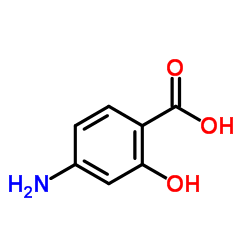
4-aminosalicylic acid structure
|
Common Name | 4-aminosalicylic acid | ||
|---|---|---|---|---|
| CAS Number | 65-49-6 | Molecular Weight | 153.135 | |
| Density | 1.5±0.1 g/cm3 | Boiling Point | 380.8±32.0 °C at 760 mmHg | |
| Molecular Formula | C7H7NO3 | Melting Point | 135-145 °C(lit.) | |
| MSDS | Chinese USA | Flash Point | 184.1±25.1 °C | |
| Symbol |

GHS07 |
Signal Word | Warning | |
Use of 4-aminosalicylic acid4-Aminosalicylic acid (ASA) is an orally active antibiotic and has the potential to treat tuberculosis[1]. |
| Name | 4-aminosalicylic acid |
|---|---|
| Synonym | More Synonyms |
| Description | 4-Aminosalicylic acid (ASA) is an orally active antibiotic and has the potential to treat tuberculosis[1]. |
|---|---|
| Related Catalog | |
| References |
| Density | 1.5±0.1 g/cm3 |
|---|---|
| Boiling Point | 380.8±32.0 °C at 760 mmHg |
| Melting Point | 135-145 °C(lit.) |
| Molecular Formula | C7H7NO3 |
| Molecular Weight | 153.135 |
| Flash Point | 184.1±25.1 °C |
| Exact Mass | 153.042587 |
| PSA | 83.55000 |
| LogP | 1.14 |
| Vapour Pressure | 0.0±0.9 mmHg at 25°C |
| Index of Refraction | 1.691 |
| Water Solubility | 2 g/L (20 ºC) |
Synonym:PAS; 4-Amino-2-hydroxybenzoic aci Section 2 - COMPOSITION, INFORMATION ON INGREDIENTS
Risk Phrases: None Listed. Section 3 - HAZARDS IDENTIFICATION EMERGENCY OVERVIEW
Light sensitive.Air sensitive. Potential Health Effects Eye: Causes eye irritation. Skin: May cause skin irritation. Ingestion: May cause irritation of the digestive tract. Inhalation: May cause respiratory tract irritation. Chronic: No information found. Section 4 - FIRST AID MEASURES Eyes: Flush eyes with plenty of water for at least 15 minutes, occasionally lifting the upper and lower eyelids. Get medical aid. Skin: Get medical aid. Flush skin with plenty of water for at least 15 minutes while removing contaminated clothing and shoes. Get medical aid if irritation develops or persists. Wash clothing before reuse. Ingestion: If victim is conscious and alert, give 2-4 cupfuls of milk or water. Never give anything by mouth to an unconscious person. Get medical aid. Do NOT induce vomiting. If conscious and alert, rinse mouth and drink 2-4 cupfuls of milk or water. Inhalation: Remove from exposure and move to fresh air immediately. If not breathing, give artificial respiration. If breathing is difficult, give oxygen. Get medical aid if cough or other symptoms appear. Get medical aid. Notes to Physician: Antidote: None reported. Section 5 - FIRE FIGHTING MEASURES General Information: As in any fire, wear a self-contained breathing apparatus in pressure-demand, MSHA/NIOSH (approved or equivalent), and full protective gear. During a fire, irritating and highly toxic gases may be generated by thermal decomposition or combustion. Extinguishing Media: Use agent most appropriate to extinguish fire. Section 6 - ACCIDENTAL RELEASE MEASURES General Information: Use proper personal protective equipment as indicated in Section 8. Spills/Leaks: Vacuum or sweep up material and place into a suitable disposal container. Clean up spills immediately, observing precautions in the Protective Equipment section. Avoid generating dusty conditions. Provide ventilation. Place under an inert atmosphere. Section 7 - HANDLING and STORAGE Handling: Wash thoroughly after handling. Use with adequate ventilation. Minimize dust generation and accumulation. Avoid breathing dust, vapor, mist, or gas. Avoid contact with eyes, skin, and clothing. Keep container tightly closed. Avoid ingestion and inhalation. Store protected from light. Handle under an inert atmosphere. Store protected from air. Storage: Store in a cool, dry, well-ventilated area away from incompatible substances. Do not expose to air. Store protected from light. Store under an inert atmosphere. Section 8 - EXPOSURE CONTROLS, PERSONAL PROTECTION Engineering Controls: Facilities storing or utilizing this material should be equipped with an eyewash facility and a safety shower. Use adequate ventilation to keep airborne concentrations low. Exposure Limits CAS# 65-49-6: Personal Protective Equipment Eyes: Wear appropriate protective eyeglasses or chemical safety goggles as described by OSHA's eye and face protection regulations in 29 CFR 1910.133 or European Standard EN166. Skin: Wear appropriate protective gloves to prevent skin exposure. Clothing: Wear appropriate protective clothing to prevent skin exposure. Respirators: A respiratory protection program that meets OSHA's 29 CFR 1910.134 and ANSI Z88.2 requirements or European Standard EN 149 must be followed whenever workplace conditions warrant respirator use. Follow the OSHA respirator regulations found in 29 CFR 1910.134 or European Standard EN 149. Use a NIOSH/MSHA or European Standard EN 149 approved respirator if exposure limits are exceeded or if irritation or other symptoms are experienced. Section 9 - PHYSICAL AND CHEMICAL PROPERTIES Physical State: Solid Color: Not available. Odor: Odorless or slight acetous pH: Not available. Vapor Pressure: Not available. Viscosity: Not available. Boiling Point: Not available. Freezing/Melting Point: 147 deg C dec Autoignition Temperature: Not available. Flash Point: Not available. Explosion Limits, lower: Not available. Explosion Limits, upper: Not available. Decomposition Temperature: Solubility in water: practically insoluble in benzene Specific Gravity/Density: Molecular Formula: C7H7NO3 Molecular Weight: 153.14 Section 10 - STABILITY AND REACTIVITY Chemical Stability: Stable under normal temperatures and pressures. Conditions to Avoid: Incompatible materials, light, exposure to air. Incompatibilities with Other Materials: Air. Hazardous Decomposition Products: Nitrogen oxides, carbon monoxide, irritating and toxic fumes and gases, carbon dioxide. Hazardous Polymerization: Has not been reported. Section 11 - TOXICOLOGICAL INFORMATION RTECS#: CAS# 65-49-6: VO1225000 LD50/LC50: CAS# 65-49-6: Draize test, rabbit, eye: 100 mg/24H Moderate; Oral, mouse: LD50 = 4 gm/kg; Oral, rabbit: LD50 = 3650 mg/kg. Carcinogenicity: 4-aminosalicylic acid - Not listed by ACGIH, IARC, or NTP. Other: See actual entry in RTECS for complete information. Section 12 - ECOLOGICAL INFORMATION Section 13 - DISPOSAL CONSIDERATIONS Dispose of in a manner consistent with federal, state, and local regulations. Section 14 - TRANSPORT INFORMATION IATA Not regulated as a hazardous material. IMO Not regulated as a hazardous material. RID/ADR Not regulated as a hazardous material. Section 15 - REGULATORY INFORMATION European/International Regulations European Labeling in Accordance with EC Directives Hazard Symbols: Not available. Risk Phrases: Safety Phrases: S 24/25 Avoid contact with skin and eyes. S 28A After contact with skin, wash immediately with plenty of water. S 37 Wear suitable gloves. S 45 In case of accident or if you feel unwell, seek medical advice immediately (show the label where possible). WGK (Water Danger/Protection) CAS# 65-49-6: No information available. Canada CAS# 65-49-6 is listed on Canada's NDSL List. CAS# 65-49-6 is listed on Canada's Ingredient Disclosure List. US FEDERAL TSCA CAS# 65-49-6 is listed on the TSCA inventory. SECTION 16 - ADDITIONAL INFORMATION N/A |
CHEMICAL IDENTIFICATION
HEALTH HAZARD DATAACUTE TOXICITY DATA
MUTATION DATA
|
| Symbol |

GHS07 |
|---|---|
| Signal Word | Warning |
| Hazard Statements | H319 |
| Precautionary Statements | P305 + P351 + P338 |
| Personal Protective Equipment | dust mask type N95 (US);Eyeshields;Gloves |
| Hazard Codes | Xi:Irritant |
| Risk Phrases | R36/37/38 |
| Safety Phrases | S26-S37/39-S45-S53 |
| RIDADR | UN 1789 8/PG 3 |
| WGK Germany | 2 |
| RTECS | VO1225000 |
| HS Code | 29225000 |
| Precursor 10 | |
|---|---|
| DownStream 9 | |
| HS Code | 29225000 |
|---|
|
Synthesis of lysozyme-metallacarborane conjugates and the effect of boron cluster modification on protein structure and function.
ChemBioChem. 16(3) , 424-31, (2015) Two complementary methods, "in solution" and "in solid state", for the synthesis of lysozyme modified with metallacarborane (cobalt bis(dicarbollide), Co(C2 B9 H11 )2 (2-) ) were developed. As metalla... |
|
|
Therapeutic antibodies reveal Notch control of transdifferentiation in the adult lung.
Nature 528 , 127-31, (2015) Prevailing dogma holds that cell-cell communication through Notch ligands and receptors determines binary cell fate decisions during progenitor cell divisions, with differentiated lineages remaining f... |
|
|
Simple and accurate quantitative analysis of 20 anti-tuberculosis drugs in human plasma using liquid chromatography-electrospray ionization-tandem mass spectrometry.
J. Pharm. Biomed. Anal. 102 , 9-16, (2014) A simple and accurate liquid chromatography (LC)-tandem mass spectrometry (MS/MS) method for the quantitation of 20 anti-tuberculosis (anti-TB) drugs in human plasma, was developed as a tool for thera... |
| PAS |
| 4-Asa |
| Bactylan |
| Pasalon-rakeet |
| Aminox |
| Tubersan |
| para-amino salicylic acid |
| Salvis |
| Paracipan |
| 4-Amino-2-hydroxybenzoic acid |
| Sanipirol |
| Lepasen |
| PASA |
| Apas |
| Pasmicina |
| p-aminosalicylic acid |
| Benzoic acid, 4-amino-2-hydroxy- |
| Rezipas |
| 4-amino-salicylic acid |
| EINECS 200-613-5 |
| ZR CQ DVQ |
| Passodico |
| PASK |
| 4-Aminosalicylic acid |
| MFCD00007789 |
| A 1909 |
| Aminosalicylic Acid |
| Aminacyl |
| Paser |
| PAS-C |
| Pasem |
| Mesalazine Impurity 5 |
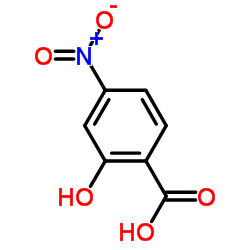 CAS#:619-19-2
CAS#:619-19-2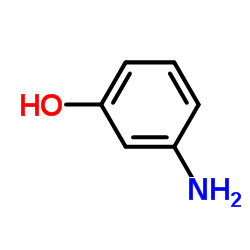 CAS#:591-27-5
CAS#:591-27-5 CAS#:17980-39-1
CAS#:17980-39-1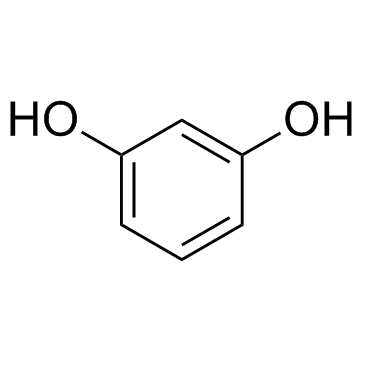 CAS#:108-46-3
CAS#:108-46-3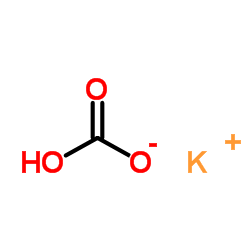 CAS#:298-14-6
CAS#:298-14-6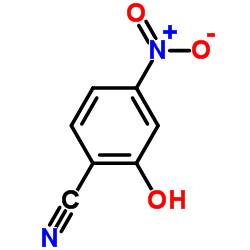 CAS#:39835-14-8
CAS#:39835-14-8 CAS#:43134-76-5
CAS#:43134-76-5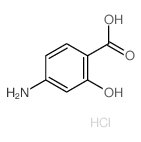 CAS#:6018-18-4
CAS#:6018-18-4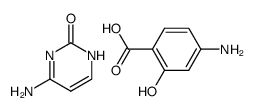 CAS#:65944-71-0
CAS#:65944-71-0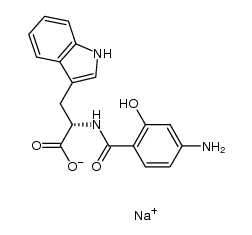 CAS#:1122102-49-1
CAS#:1122102-49-1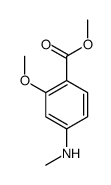 CAS#:106868-33-1
CAS#:106868-33-1 CAS#:10462-80-3
CAS#:10462-80-3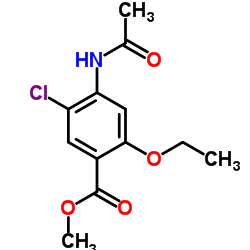 CAS#:4235-43-2
CAS#:4235-43-2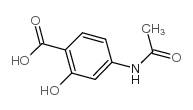 CAS#:50-86-2
CAS#:50-86-2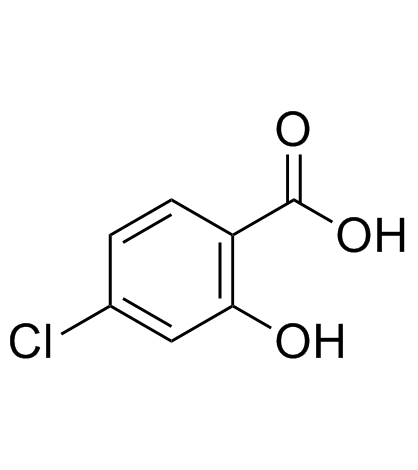 CAS#:5106-98-9
CAS#:5106-98-9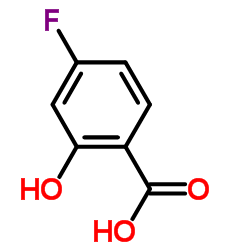 CAS#:345-29-9
CAS#:345-29-9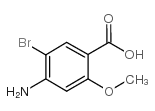 CAS#:35290-97-2
CAS#:35290-97-2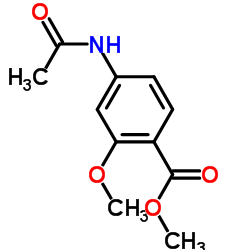 CAS#:4093-29-2
CAS#:4093-29-2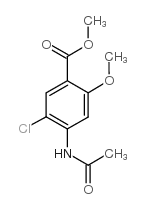 CAS#:4093-31-6
CAS#:4093-31-6
